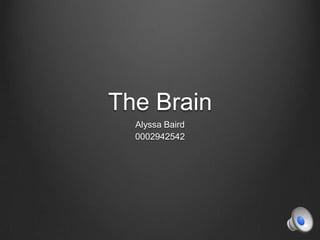
Baird alyssa level2.4_challenge
- 2. When playing the game “Word Bubbles”, you would put together words based off of a stem given to you. This game used the Neocortex part of the brain. In this part of your brain, language skills are strengthened, as well as imagination, problem solving skills, and abstract thoughts.
- 3. When playing the game “Eagle Eye”, a bird and a number would pop up on your screen at the same time. They would then disappear and you would have to click where you remember the bird being and select the correct number. This game used the Limbic part of your brain. This is where your memory comes from, as well as your valued judgments and emotions.
- 4. The Challenge: Mind Games This template is required. Complete the steps in the spaces provided below. Name:Alyssa Baird If you worked in a team, please list your teammates’ first and last names below: Step 1: Check that you have completed the following: Module 2 Played a game using one of the sites listed on the assignment instructions. Step 2: Answer the following questions using course concepts: 1. What game did you play? I played multiple games online using the site Lumosity. There were different types of games from memory games, to quick thinking, to cognative. 2. What parts of the brain were engaged while playing the game? The majority of the games I played focused mainly on the Limbic part of the brain. They were developed to help memory skills. For example one of the games I playedwas called Eagle Eye. You would have a small section of screen in which a bird would appear as well as a number. Once they both dissapeared, you would have to click where you remember the bird being and the select the number you saw. The closer your click to where the actual bird was, the more points, as well as your points for selecting the right number. The more you got right, the harder the game would get. Your section of screen would get bigger and the bird and number would appear for a smaller amount of time. Another set of games I played focused on cognative and math skills. A game called "Word Bubbles" was all about putting words together. You would start out with a word stem and make as many words from it as you could in a certain amount of time. The other game was called "Raindrops" and it focused on mental calculations. Raindrops with equations in them would fall from the sky and you would have to enter in the answer before they hit the bottom of the screen. Both of these games focus on the Neocortex part of the brain. This part of the brain has an infininte ability to learn and is where learning skills, such as language, mathematics, and science are aquired. 3. How does engaging in play help shape your brain? By playing, we not only shape our brains, but improve our brains. In play, we can expand our brains. We can improve our memory skills, language skills, math skills, and even our creative problem solving skills. Studies also show that more attention will be paid to academics after children are given opportunities to have free play. 4. Why is it important to continue brain play as you age? Brain play not only helps you physically as you age, but also mentally. From the reading I did in Module 2, I learned that playing as you age can help with your memory, including cutting your chances of getting Alhimers in half, help your brain continue to learn and become more "flexible", and physical play has been show to increase cognitive benefits. By exercising your brain in play, you keep your mind sharp, focused, and "young". Step 3: Get Creative! Create a visual representation of the brain. Be sure to showcase what parts of the brain were engaged while playing your game. !